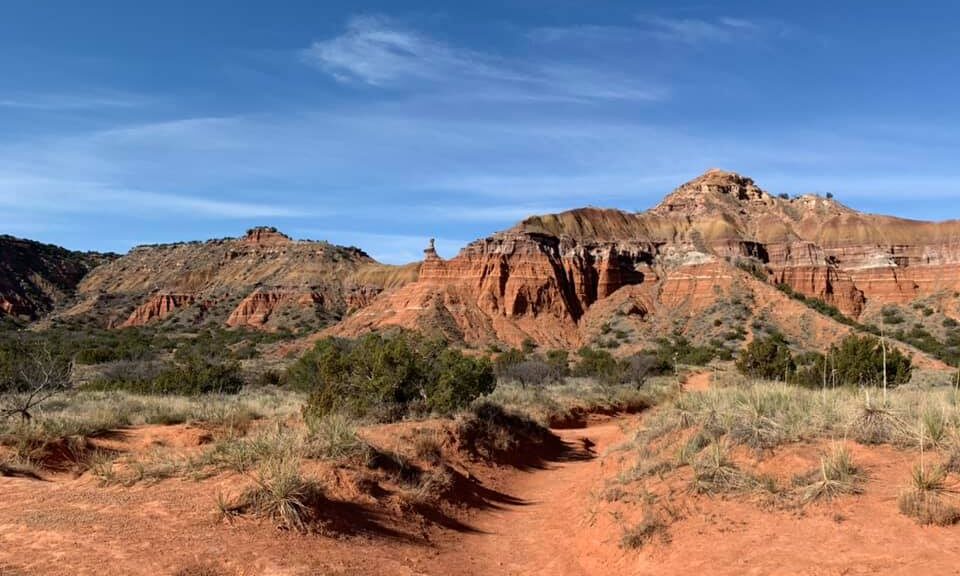
From the Project Director: Museums and Archives
Growing up in the Texas Panhandle, there were two field trips that happened every Spring. One was a visit to Palo Duro Canyon. Mom would pack a brown paper bag with a ham and cheese sandwich, Doritos, and a Coke wrapped in aluminum foil. As our bus descended what I now realize as an incredibly precarious road down to the canyon floor, my energy buzzed. I prepared myself for the sharp turns of the Sad Monkey Railroad train ride and crossed my fingers for a Red River that was not dry.
The other field trip was to the Panhandle Plains Historical Museum. In the 1980s the museum was still full of dioramas depicting life on the Llano Estacado. Underneath glass someone had recreated what they clearly perceived as the emptiness of the plains. A lone, maybe 3” inch high covered wagon was surrounded by pale green waves of plastic (?), plaster (?) llano. The fake sky was pale blue, almost white. It seemed like this might be the loneliest place on earth. But . . . I knew it was not. As we wandered through Pioneer Town where they had reconstructed Canyon, Texas as it was perhaps in the 1880s or 1890s, I always felt not just sad, but embarrassed. Where was I? I knew my dad’s ancestors had been crossing the llano for hundreds of years. And I knew Amarillo’s barrio held countless stories like those of my Grandpa Juan Alonzo, stories of familias mexicanas that had come north in the early part of the twentieth century to work the Santa Fe Railroad. I knew I was on Comanche land, Kiowa land, southern Cheyenne land. Because Dad loved history and western novels, I knew the Battle of Palo Duro Canyon had happened in 1874. But those stories were nowhere in the museum. The Coronado Expedition was portrayed by Spanish conquistador spurs and reconstructed armor. I remember it only because the spurs looked like implements of torture and that was the only place where a Spanish surname was visible. There was a mannequin wearing the traditional regalia of the Comanche, a Kiowa cradleboard, a cornhusk doll and a toy buffalo made out of real buffalo hide. There were no names attached to those pieces, but I wondered who they had belonged to. Barbed wire was proclaimed an immense sign of progress. It would be decades before I knew what barbed wire meant and that my great-great grandfather had gone to prison for cutting it. From my place in front of the plexiglass, I wondered if we had ever been alive. Sure, I knew my heart was beating, but I really wondered.
I tell this story because as I am writing I am getting prepared for this weekend’s Following the Manito Trail exhibit at the Millicent Rogers Museum in Taos. It has taken a long time for the exhibit to come to fruition and I am so grateful to have been able to take part. Although my grandparents did not move north to Wyoming as the manito families represented in this exhibit did, what I learned through this work is this: our manito communities were always moving back and forth between here and “there” and “there” was sometimes Wyoming, sometimes Texas, Arizona, or California. We brought home wherever we ended up. All that being said, for me, working with a museum did not come without trepidation. Museums make me nervous. I learned very early on that they can be exploitative, colonizing spaces that manipulate history to fit mainstream narratives. Often, they erase and cover the stories that trouble and complicate timelines, maps and dioramas. It is not an exaggeration to say a museum can be a painful place for so many of us.
Twenty years ago, I took a class with Dr. Sylvia Rodríguez entitled The Anthropology of Tourism at the University of New Mexico. I kept the syllabus and all the books from that course. Over the past month, I’ve been referring to them again and again.
Following the Manito Trail and the Manito Community Memory Project are attempts to decolonize the space of the museum and the archive. What happens if we take the power to tell our own story? What happens if we approach our relatives with respect for their experience and listen? What happens when we ask for permission from our elders, from our community to share their knowledge? These are my questions. I don’t have an answer. But as I finish this piece, I do feel I can say one thing. This is for us.
One thought on “From the Project Director: Museums and Archives”
Can’t wait to read the stories and experience this project unfold things I never knew.